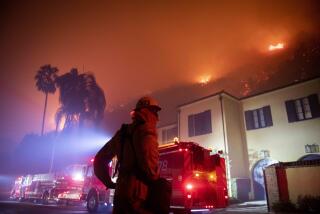Public Takes Monday Closing of 2 County S&Ls; in Stride
- Share via
Word that federal regulators had decided to spend a record $1.35 billion to liquidate two insolvent county savings banks was headline news across the country Monday.
That kind of news always makes Bob Morris a little nervous. Morris is president of New Mexico Federal Savings & Loan, so publicity that reflects badly on the thrift community concerns the Albuquerque savings executive.
“I told my branch managers to let me know if we had any inquiries from depositors,” Morris said late Monday. “But so far, we haven’t. I guess people have gotten inured (to the industry’s woes),” he said.
Morris’ assessment of public reaction to the liquidation of American Diversified Savings Bank and North America Savings & Loan Assn. is one that seems to be supported by consumers, industry insiders and industry analysts alike.
The precarious financial health of the nation’s thrifts has been bruited about for several years now, so people are apparently comfortable with repeated government assurances that the deposit insurance system will take care of them in the event their own S&L; goes under.
“I did a radio call-in interview in Seattle this morning,” said Noel Fahey, director of research for the U.S. League of Savings Institutions. “Not one of the callers asked me about the safety of their money. That just wasn’t a concern.”
Some industry watchers said the public should be concerned that the Federal Savings and Loan Insurance Corp. doesn’t have nearly enough money in its coffers to handle what the Government Accounting Office recently estimated is a potential insurance liability that could grow to as much as $65 billion in the next few years.
Stephen Skaggs, vice president of Sheshunoff & Co., a financial industry consulting firm in Austin, said that while “closures and mergers have no real public impact,” people should be concerned.
“There have been so many that people get immune. But it is not appropriate to say that these liquidations are a sign of strength in the system as a whole,” Skaggs said.
“The industry is a pretty troubled one, and there are a lot of insolvent institutions that FSLIC still has to work out. . . . I don’t think it is clear to most analysts just how the FSLIC fund will prove to be adequate.”
Depositors with less than the $100,000 insured limit in their accounts will be covered by the federal insurance, “so I don’t think the public will be concerned, but they should be concerned,” said Edward Carpenter, a bank and S&L; consultant in Costa Mesa.
While Congress has voiced its intention to protect the financial integrity of FSLIC, “I haven’t seen those assurances in a statute anywhere,” Carpenter said.
But industry insiders like Fahey maintain that FSLIC is in the midst of a major recapitalization program and can raise up to $20 billion in the next few years.
They also point out that Congress has twice voiced its intention to support the FSLIC fund so that all insured savings accounts are covered up to the $100,000 maximum.
And that leads most consumers to react like Anna Marie Colburn, 23, of Mission Viejo.
In a brief interview Monday afternoon as she was entering a branch of the S&L; where she keeps her money, Colburn said that she has faith in the system because “the government will pay if the bank goes bad.”
Some insolvent S&Ls; failed because of “poor management and embezzlement. . . . But they (deposits) are all insured.” said Roger Katz, 38, a United Parcel Service worker who said he spent two years with the Federal Deposit Insurance Corp.--the banking industry’s insurer.
Of more than two dozen county residents interviewed outside various S&Ls; Monday, just one, Joyce Miller of Irvine, expressed concern about the solvency of the insurance fund. And Miller happens to work for American Savings & Loan, which is owned by Financial Corp. of America, the nation’s largest and, by most accounts, sickest, S&L.;
Miller said she doesn’t “have that much money, so I can sleep at night. But if I had a lot of money, I’d be pulling it out. Would you want it left in (an S&L;) with the situation the way it is?
“FSLIC doesn’t have that much money anymore.”
Times staff writers Laura Kurtzman and Floyd Whaley contributed to this report. Related stories, Pages 1 and 10, this section, and Part I, Page 1.
More to Read
Inside the business of entertainment
The Wide Shot brings you news, analysis and insights on everything from streaming wars to production — and what it all means for the future.
You may occasionally receive promotional content from the Los Angeles Times.










